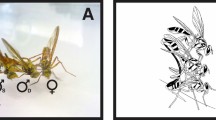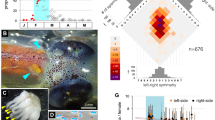Abstract
DURING mating a male butterfly leaves a spermatophore in the bursa copulatrix of the female. One spermatophore results from each mating and so the number of times a female has mated can be determined by dissection of the bursa. Spermatophores can almost always be recognized even when old and collapsed and they persist throughout the life of the female1 and in old and dried out museum specimens. In most butterflies the sex ratio is 1 to 1, wild-caught females are hardly ever virgins, most have mated at least once, and some have mated up to ten times.
This is a preview of subscription content, access via your institution
Access options
Subscribe to this journal
Receive 51 print issues and online access
$199.00 per year
only $3.90 per issue
Buy this article
- Purchase on Springer Link
- Instant access to full article PDF
Prices may be subject to local taxes which are calculated during checkout
Similar content being viewed by others
References
Burns, J. M., Proc. US Nat. Acad. Sci., 61, 852 (1968).
Owen, D. F., and Chanter, D. O., J. Zool., 157, 345 (1969).
Owen, D. F., Nature, 225, 662 (1970).
Chanter, D. O., and Owen, D. F., J. Zool., 166, 363 (1972).
Author information
Authors and Affiliations
Rights and permissions
About this article
Cite this article
OWEN, D., OWEN, J. & CHANTER, D. Low Mating Frequencies in an African Butterfly. Nature 244, 116–117 (1973). https://doi.org/10.1038/244116b0
Received:
Published:
Issue Date:
DOI: https://doi.org/10.1038/244116b0
This article is cited by
Comments
By submitting a comment you agree to abide by our Terms and Community Guidelines. If you find something abusive or that does not comply with our terms or guidelines please flag it as inappropriate.



